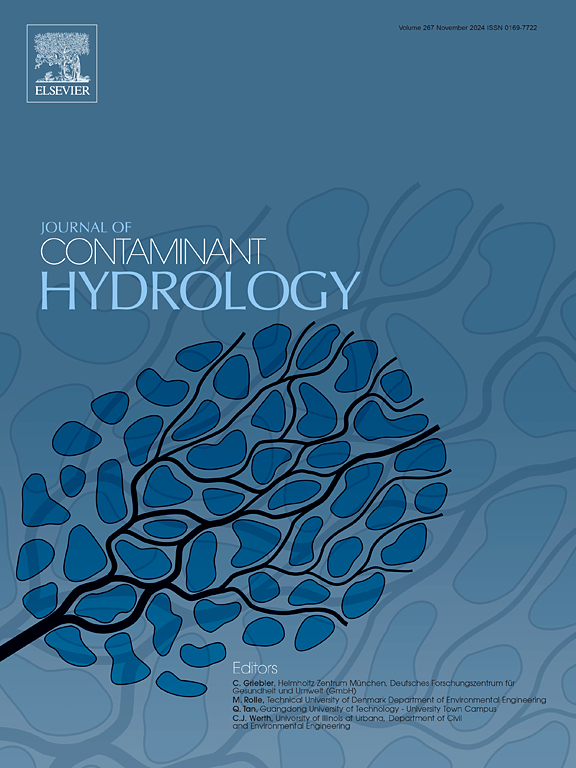Distribution of potentially toxic elements in sediments of the municipal river channel (Balu), Dhaka, Bangladesh: Ecological and health risks assessment
IF 3.5
3区 环境科学与生态学
Q2 ENVIRONMENTAL SCIENCES
引用次数: 0
Abstract
The concern of potential toxic elements (PTEs) contamination in the river ecosystem is growing due to anthropological activity. The contents of seven PTEs in sediments from the Balu River channel were analyzed using atomic absorption spectroscopy (AAS) and an environmental risk model. Several PTEs were found in the sediment at high levels, including zinc (Zn), copper (Cu), arsenic (As), lead (Pb), cadmium (Cd), nickel (Ni), and mercury (Hg), that might pose a risk to human and ecological health. The highest mean concentration of PTEs in sediment followed in decreasing order Zn (1365.21 mg/kg) > Cu (149.34 mg/kg) > Pb (46.34 mg/kg) > Ni (34.78 mg/kg) > As (6.31 mg/kg) > Cd (2.34 mg/kg) > Hg (1.03 mg/kg). In addition, most of these PTEs were significantly correlated (p < 0.05) among the sites and exceeded the safety guideline value. The geo-accumulation index (Igeo), contamination factor (CF), and pollution load index (PLI) showed high levels of PTEs contamination and moderately polluted to highly polluted levels of these elements. At the BL3, BL4, and BL6 sites within the study site, the ecological risk (PERI) score was extremely high, and the PERI values range found was from 75.39 to 355.72. Every PTE had a slightly greater concentration during the dry season than the wet season. Interestingly, PTE accumulation from sediment indicated non-carcinogenic risk () in human health, whereas most of the sites showed carcinogenic risk () to human health (adult and child) due to Cd and Ni accumulation. Multivariate statistical analysis (MVSA) indicated the most likely anthropological sources were the untreated wastes discharged in the river sampling area. People who come into contact with polluted sediments are constantly exposed to Ni and Cd pollution, which increases the risk of cancer and non-cancerous diseases. So, continuous PTE monitoring is advised by this study to assess ecological and human health risks.

孟加拉国达卡市河道(巴鲁)沉积物中潜在有毒元素的分布:生态和健康风险评估
由于人类的活动,对河流生态系统中潜在有毒元素(PTEs)污染的关注日益增加。采用原子吸收光谱法(AAS)和环境风险模型分析了巴鲁河河道沉积物中7种pte的含量。沉积物中发现锌(Zn)、铜(Cu)、砷(As)、铅(Pb)、镉(Cd)、镍(Ni)和汞(Hg)等pte含量较高,可能对人类健康和生态健康构成威胁。沉积物中pte的最高平均浓度依次为Zn (1365.21 mg/kg)和gt;铜(149.34 mg/kg) >;铅(46.34 mg/kg) >;Ni (34.78 mg/kg) >;As (6.31 mg/kg) >;Cd (2.34 mg/kg) >;汞(1.03 mg/kg)。此外,这些pte大多显著相关(p <;0.05),超过了安全指标值。地质累积指数(Igeo)、污染因子(CF)和污染负荷指数(PLI)显示出pte的高污染水平和中度至重度污染水平。研究点内BL3、BL4和BL6 3个样点的生态风险(PERI)得分极高,范围为75.39 ~ 355.72。各PTE在旱季的浓度略高于雨季。有趣的是,沉积物中PTE的积累表明人体健康无致癌风险(HQdermal),而大多数部位由于Cd和Ni的积累对人体健康(成人和儿童)显示致癌风险(CRdermal)。多变量统计分析(MVSA)表明,最可能的人类学来源是河流采样区排放的未经处理的废物。接触受污染沉积物的人不断暴露于Ni和Cd污染中,这增加了患癌症和非癌症疾病的风险。因此,本研究建议对PTE进行持续监测,以评估生态和人类健康风险。
本文章由计算机程序翻译,如有差异,请以英文原文为准。
求助全文
约1分钟内获得全文
求助全文
来源期刊

Journal of contaminant hydrology
环境科学-地球科学综合
CiteScore
6.80
自引率
2.80%
发文量
129
审稿时长
68 days
期刊介绍:
The Journal of Contaminant Hydrology is an international journal publishing scientific articles pertaining to the contamination of subsurface water resources. Emphasis is placed on investigations of the physical, chemical, and biological processes influencing the behavior and fate of organic and inorganic contaminants in the unsaturated (vadose) and saturated (groundwater) zones, as well as at groundwater-surface water interfaces. The ecological impacts of contaminants transported both from and to aquifers are of interest. Articles on contamination of surface water only, without a link to groundwater, are out of the scope. Broad latitude is allowed in identifying contaminants of interest, and include legacy and emerging pollutants, nutrients, nanoparticles, pathogenic microorganisms (e.g., bacteria, viruses, protozoa), microplastics, and various constituents associated with energy production (e.g., methane, carbon dioxide, hydrogen sulfide).
The journal''s scope embraces a wide range of topics including: experimental investigations of contaminant sorption, diffusion, transformation, volatilization and transport in the surface and subsurface; characterization of soil and aquifer properties only as they influence contaminant behavior; development and testing of mathematical models of contaminant behaviour; innovative techniques for restoration of contaminated sites; development of new tools or techniques for monitoring the extent of soil and groundwater contamination; transformation of contaminants in the hyporheic zone; effects of contaminants traversing the hyporheic zone on surface water and groundwater ecosystems; subsurface carbon sequestration and/or turnover; and migration of fluids associated with energy production into groundwater.
 求助内容:
求助内容: 应助结果提醒方式:
应助结果提醒方式:


